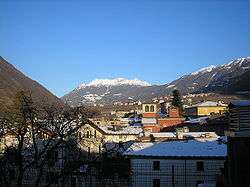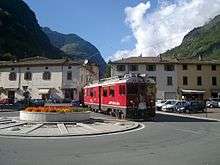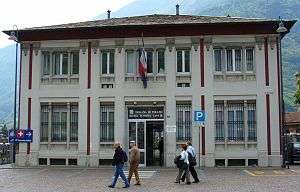Tirano
| Tirano | |
|---|---|
| Comune | |
| Città di Tirano | |
 | |
.svg.png) Tirano within the Province of Sondrio | |
 Tirano Location of Tirano in Italy | |
| Coordinates: 46°12′59″N 10°10′08″E / 46.21639°N 10.16889°ECoordinates: 46°12′59″N 10°10′08″E / 46.21639°N 10.16889°E | |
| Country | Italy |
| Region | Lombardy |
| Province / Metropolitan city | Province of Sondrio (SO) |
| Frazioni | Baruffini, Cologna, Madonna di Tirano, Roncaiola |
| Area | |
| • Total | 32 km2 (12 sq mi) |
| Elevation | 441 m (1,447 ft) |
| Population (31 December 2015) | |
| • Total | 9,130 |
| • Density | 290/km2 (740/sq mi) |
| Demonym(s) | Tiranesi |
| Time zone | CET (UTC+1) |
| • Summer (DST) | CEST (UTC+2) |
| Postal code | 23037 |
| Dialing code | 0342 |
| Patron saint | Martin of Tours |
| Saint day | 11 November |
| Website | Official website |
Tirano (Lombard: Tiràn, German: Thiran) is a town in Valtellina, located in the province of Sondrio in northern Italy. It has 9,130 inhabitants (2015) and is adjacent to the Switzerland-Italy boundary. The river Adda flows through the town.
Overview
Tirano has two neighboring railway stations. One, a standard gauge station, is operated by Trenitalia, the state railway company, and is terminus of the Tirano–Lecco railway.
The other, a metre gauge station, is operated by the Rhaetian Railway (RhB). The line of the Bernina Railway connects St. Moritz (Canton of Graubünden/Switzerland) with Tirano. The complete line was opened in 1910. In 2008 the Bernina Railway as well as the Albula Railway were recorded from UNESCO in the list of UNESCO World Heritage Sites.
Located nearby is the Catholic shrine of the Madonna di Tirano, a major tourist attraction. The shrine is dedicated to the appearance of the Blessed Mother to Mario Degli Omodei on September 29, 1504, an event religious pilgrims credit with ending a pestilence.
The Palazzo Salis close by the municipal offices is a remarkable example of the use of trompe l'oeil to create the illusion of architectural features.[1]
Despite its population of less than 10,000, Tirano is considered a city because of the walls that were built to protect it.
History
%2C_Tirano%2C_Valtelline._Postmarked_Lecco_to_Bern._Franked%2C_12_June%2C_1911.jpg)
Gallery
 Basilica
Basilica Palazzo Salis
Palazzo Salis Church of St. Perpetua
Church of St. Perpetua

 Quadrio Palace
Quadrio Palace
See also
References
- ↑ Paull, J. (2015) Tirano's Palace of Trompe L'Oeil: A Photographic Exhibition by John Paull SlideShare.
External links
![]() Media related to Tirano at Wikimedia Commons
Media related to Tirano at Wikimedia Commons